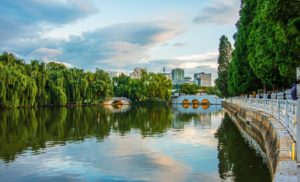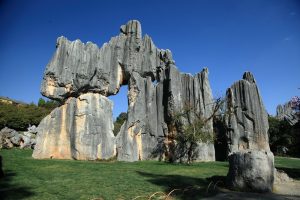
20 Days Yunnan (China)-Myanmar Overland Tour from Kunming to Yangon

Tour Overview
This Yunnan and Burma Old Road Tour takes you on a scenic journey starting in Kunming and covering iconic destinations such as Shangri-La, Dali, and Lijiang before heading to...
Code of Tour: YET0000063677
Length of Travel: 20 Day
Destinations of Tour: Kunming-Shangri La-Lijiang-Dali-Baoshan-Tengchong-Ruili-Muse-Lashio-Mandalay-Bagan-Inle Lake-Ynagon
Departure City: Kunming
Price of Tour: Request
Type of Tour:
Features of Tour: Yunnan-indochina tours
This Yunnan and Burma Old Road Tour takes you on a scenic journey starting in Kunming and covering iconic destinations such as Shangri-La, Dali, and Lijiang before heading to the western Yunnan-Burma border. The tour explores Tengchong, Mangshi, and Ruili, ultimately crossing into Myanmar through the Ruili Border Gate. In Myanmar, you will meet your tour guide and continue to explore Mandalay and Yangon, with a beautiful cruise along the Irrawaddy River. The Yunnan-Burma Road, a historic route constructed during the Second Sino-Japanese War, serves as the backbone of this journey, linking China and Burma (Myanmar) through rugged mountainous terrain.
Tour Highlights
- Visit the largest Tibetan monastery in Yunnan at Songzanlin Monastery in Shangri-La.
- Explore the breathtaking Tiger Leaping Gorge, one of the deepest gorges in the world.
- Discover the unique cultural richness of Lijiang Old Town and its UNESCO-listed heritage.
- Travel along the historic Burma Road, built during World War II with manual labor.
- Cross the border into Myanmar and explore its highlights, including Mandalay, Bagan, and Inle Lake.
- Experience a cruise on the Irrawaddy River, soaking in the natural beauty and river life.
Day by Day Itinerary
Day 1 Arrive in Kunming
Sightseeing and Activities: the Green Lake Park
Accommodation: Kunming
Meals: No meals
Welcome to Kunming, the Spring City of China! Upon arrival at the Kunming airport/train station, the local tour guide and driver will meet you in the arrival hall and escort you to your hotel.You’ll begin your journey to the diverse and captivating province of Yunnan from the capital city, Kunming.

After a short rest, stroll in the most picturesque park in Kunming urban area – the Green Lake Park, a charming area of tea houses and small boutiques selling handicrafts and beautiful local paintings. Here you can share the happiness of local people’s doing tai chi, performing local opera, and other vibrant activities. If you visit the park in November or December, you will see the grandeur of huge flocks of red-beaked seagulls that migrate there from Siberia.
Day 2 Kunming – Stone Forest – Kunming
Sightseeing and Activities:The Stone Forest, Sani Village, the Flowers and Birds Market
Accommodation: Kunming
Meals: Breakfast, Lunch

After breakfast, you’ll be driven 86 km to the renowned Stone Forest, the ‘First Wonder of the World’. You’ll marvel at its natural stone masterpieces and be bewitched by the intricate formations. You feel like come into a ‘stone world’. The Stone Forest is in Shilin Yi Nationality Autonomous County, which is about 120 kilometers from Kunming and requires only a three-hour drive. It covers an area of 400 square kilometers (96,000 acres) and includes both large and small stone forests, as well as many other scenic spots. The Stone Forest has unique karst topography which is one of the best of its kind within China.
Afterwards, visit a minority village of Sani People, to admire their colorful minority costumes and exotic tradition cultures. You’ll have a nice chance to listen to the touching love story of Ashima told by local old people. The Sani minority people are one group of the branches of the Yi. The Sani Minority Villages around the Stone Forest cluster many small Yi ethnic villages.
After the tour, be transferred to Kunming and visit the Flowers and Birds Market in the downtown.
Day 3 Kunming-Shangri La
Day 4 Shangri-la–Tiger Leaping Gorge-Lijiang
Day 5 Lijiang
Day 6 Lijiang-Dali by Private Car
Day 7 Dali
Day 8 Dali-Tengchong
Day 9 Tengchong-Ruili
Day 10 RUILI – MUSE BORDER CROSSING – LASHIO
Day 11 LASHIO – HSIPAW (140 KM 4 HOURS)
Day 12 HSIPAW – GOKTEIK BRIDGE – PYIN OO LWIN
Day 13 PYIN OO LWIN – MANDALAY
Day 14 Mandalay
Day 15 MANDALAY – BAGAN BY BOAT
Day 16 BAGAN
Day 17 Flight to Heho, Inle Lake
Day 18 Full Day Inle Lake Excursion
Rest of the day is at leisure to relax.
Day 19 Inle Lake-Yongon by Flight
In the morning, you will fly from Heho to Yangon, meet your local guide and start Yangon city tour.
Our guide will take you to Sule Pagoda, located in the heart of Yangon City. It is surrounded by a group of impressive statues, the most notable ones being the sculptures of eight zodiacs. You can find your own zodiac sign according to the date of your birth and take pictures with it. Then we proceed to Chaukhtatgyi Pagoda, where you can view a giant reclining Buddha with 108 totems carved on his soles, each representing a different image in the six reincarnations.
Day 20 YANGON – DEPARTURE
Transfer to airport for international departure flight.
Service Included:
- Admission fees for all of the sightseeing spots listed in the itinerary;
- Meals as listed in the itinerary;
- Hotels as listed in the itinerary;
- Private English-speaking tour guide;
- Private vehicle for transfers & sightseeing with skilled driver;
- Service charge & government taxes;
- Luggage transfers between airports and hotels;
- Service charge and all government taxes;
- Travel Agency’s Responsibility Insurance coverage.
Service Excluded:
- Any arrival and departure international airfares or train tickets;
- Chinese visa fees;
- Excess baggage charged by Airlines;
- Single room supplement;
- Tips to guides and drivers;
- Personal expenses and gratuities to service staff;
- Personal travel accident insurance;
- All optional programs.


















